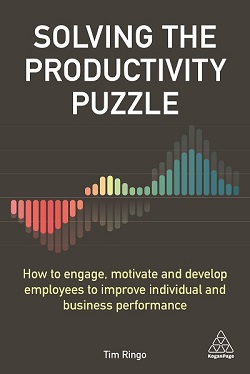
Solving the Productivity Puzzle by Tim Ringo arrives in an appealing dark cover with high-contrast white block print and a modern sweep on and old graph celebrating the transition from red under the line to blue green above the line results. When you engage, motivate, develop employees and overall improve individual and business performance – color matters. With an eye for simple graphics the implications of the cover appealed to my visual image of success.
Inside, continuation of graphic visuals and trending references to current events fulfill the promises made by the cover. Ringo offers technical discussion to set the tone of the book, with solutions to productivity questions. His references and citations are clear and well organized at the end of the chapters, making it a simple task to review any ideas and concepts that need clarification.
ABOUT THE AUTHOR: twitter.com/ringouk?lang=en
Case studies referencing known, actually recognizable companies, offer detailed ideas and strategies for improving productivity. “Solving the Productivity Puzzle” actively presents good strategies for improving the problems that exist.
Some problems exist in the leadership of these businesses. Ringo looks deep into the development of business organizations, reviewing management objectives, in order to find the particular strategy and cultural changes that need to take place to solve any productivity challenges. These studies identify problems, and allow Ringo to create diagrams and figures to explain the difficulties. These figures identify the problems and show the specific point of reference when the problem is solved.
Ringo identifies the productivity paradox, discussing the global economy and how it must consistently grow to increase human productivity. His key processes improve the overall standards on the global stage, allowing for abundant job opportunities. He talks about the rapid development of technology and communications. The explanation of how these define the outcome of productivity and why there’s more to the active use of the term productivity is broken down into value, engagement, and innovation.
AMAZON: www.amazon.com/Solving-Productivity-Puzzle-Individual-Performance/dp/1789664764
I was impressed with the use of diagrams to display the outcome expectations discovered through the use of micro-economic studies of various productivity discussions. Ringo’s analysis of organizational results included additional factors. His representation of autonomous relationships allowed for discussion of more difficult situations. By helping leaders to master the programs and rewards represented in “Solving the Productivity Puzzle” the eventual allowance of more compensation and rewards, will help to retain employees. These concepts will improve workplace employee experiences.
Studies currently trending, include personal evaluation studies that center on the negative impact of overly-productive organizations. I found the strategies within the book to be motivating. The possibilities of having more technology and better communications on the job inspires me. I hope you grab a copy of this book.
More about the author: Tim Ringo has more than 30 years of experience as a senior executive in HR consulting and HR software. He has architected and led some of the largest and most successful HR change programs in North America, Europe, Asia, and the Middle East. Author of Solving the Productivity Puzzle, Ringo is also a Chartered Fellow of the CIPD.
by John David, posted by Clay Burton
